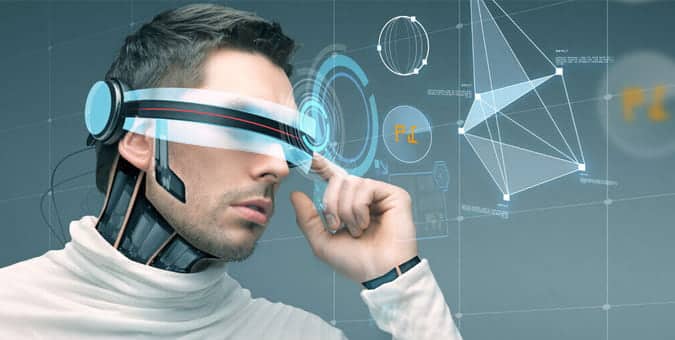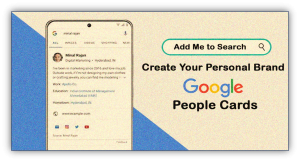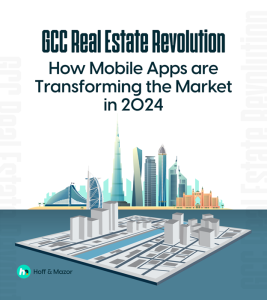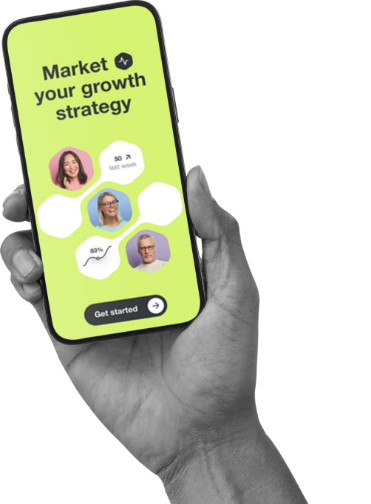Exponential growth in technology has influenced both consumers and tech industry companies. Since the last decade, digital transformation has gained momentum that allows businesses to excel in their knowledge regarding using digital technologies. A report from a research firm. ‘Frost & Sullivan’s “Global State of AI, 2022” states that eighty-seven percent of businesses have employed cutting-edge technologies such as Artificial Intelligence, Virtual Reality, and Machine Learning to execute their business operations. Employing AI technology has helped the digital ecosystem to flourish, and organizations have improved their operational efficiency and maximized the work proficiency and productivity of their teams.
With growing advancements in AI technology, more businesses have begun investing in VR and AR technology. The article briefly provides an overview of Augmented Reality and its importance in different fields including Wearable Mobile App Development. Moreover, the content expounds on the advantages of augmented reality (AR) for consumers and businesses. The readers will gain additional knowledge concerning the evolution of wearable technology and how AR and VR get integrated into wearable devices.
VR and AR Technology: The Technology For The next generation
Augmented reality (AR) is a cutting-edge technology that places digital elements onto the real world. Having computer-generated information, the tool uses GPS, sensors that provide positioning, velocity, and timing information. Augmented Reality is an AI-engaging tool that helps create an immersive learning environment. AI has completely transformed our lifestyles and trends. For instance, consumers experience different types of virtual environments including video games virtual tours, and social and educational events. AI algorithms also boost the virtual shopping experience. Voice recognition software is integrated into virtual reality and augmented reality applications that break down an audio recording into individual sounds. Moreover, AI-based algorithms measure the prospect of different word choices and phrases in a language’s vocabulary.
Other industry-specific benefits of AR technology comprises motion tracking data. Consequently, advanced AI tools allow businesses to digitize different fields including improving customer service, real-time tracking, 3D modeling, e-commerce, healthcare, and education. The users employ the algorithm to look for patterns, colors, and similar features to identify the object. Additionally, the different components comprising GPS, accelerometers, and cameras allow app developers to place an image within real-world surroundings. AI researchers have developed 3D scenes from physical photos or used images taken by smartphone cameras. They have placed digital components on the images that offered an immersive experience to the viewers.
Recent statistics provided by the global Augmented Reality market relate that the value of the augmented reality market value will reach $136.55 billion by 2025. Consequently, more businesses are employing AR technology to take their businesses to the next level.
Virtual reality (VR)
Compared to augmented reality, virtual reality offers an immersive experience to the users. Using the headset and headphones, the technology takes the users into the virtual world. It helps them gain a three-dimensional experience. For instance, game engines, content management, and computer-generated video games keep users engrossed. Moreover, a virtual tour boosts their alluring experience. The VR technology takes users into a virtual environment. For instance, virtual tours comprising educational and training materials take place without physical interaction. The technology deeply engages them in the virtual world and elevates their immersion experience.
Let’s Read How augmented reality (AR), and virtual reality (VR) Has Influenced Different Fields
Nowadays, business mobile app development has built real-time apps comprising augmented and virtual reality. They offer a new level of engaging entertainment to the users. The app designers have transformed media and entertainment by creating immersive storytelling platforms, fascinating cinematic mechanisms, and VR installations. 3D Game engines and 3D animation software allow designers to streamline the game development process, from designing game assets to testing and debugging and providing immersive gaming experience to the users.
Innovative technologies in AR and VR revolutionized the healthcare system. Both VR and AR assist healthcare practitioners learn how to operate life-saving equipment, and virtually monitor healthcare units. VR technology is helpful for new surgeons to watch surgical procedures sitting at any place and just using the headset. Virtual Applications help in visualizing building projects.AR and VR designers build information models (BIM) that help them visualize their projects efficiently without viewing the building designs in real life.
AR and VR offer immersive opportunities for education and training. Integrating these applications has brought diversity to the world of education. Learning is no more dull and monotonous for students. Instead of viewing static images or watching descriptive videos, learners can gain knowledge through AR-powered glasses, 3D content, and software having advanced sensors and image processors
Augmented reality and virtual reality streamline business operations and improve employee engagement. Virtual reality helps in the recruitment process; the companies evaluate the behavior and skills of the candidates by generating VR and AR games
The next-generation tech companies have incorporated augmented reality and virtual applications to boost wearable technology. The devices are worn on the body including smartwatches, fitness trackers, and augmented reality glasses. Consumers can conveniently track their fitness and health data while business can monitor their daily business operations
Having high flexibility, cost-effectiveness, and a variety of other benefits, VR and AR digital apps are mostly preferred by companies today. Consequently, it has helped businesses get high search engine results, boost business sales and ROI.
Wearable Technology reinvented Through AR and VR
Wearable technology has grown popular among young people. Young adults use wearables including smartwatches, fitness trackers, and augmented reality glasses that are worn on the body. The wearables are connected to computers or smartphones. Android or IOS phones are integrated with mobile applications that help people track their health and fitness. Smartwatches have apps that help prepare the grocery list or create an organized shopping list. While fitness apps keep track of running and exercise routines, monitor the heart rate and sleeping patterns. Hence, innovative apps optimize workouts and maintain health and wellness.
Current Trends in AR and VR Wearable Mobile App Development
Fashion and Entertainment Apps Innovation redefine your style
The fashion apps connect designers with consumers, facilitating them to browse their products from retailers or their online stores. Discovery platforms of the companies have catalogs that are displayed on the app. For instance, Shop Style, an inventive fashion app allow users to search their upcoming products and save the images of their favorite brands. Consequently, the app help companies to directly sell their product to their prospective consumers. In addition, the app motivates more customers to visit the sites to either search for the product or make purchases. The entertainment app provides updated brand news, stunning product images, and organizing catwalks. Thus, the fashion app provides a personalized shopping experience to the users and helps grow the fashion business.
AR and VR Education and Training apps improve the learning process
Education apps having augmented reality apps features provide immersive learning experiences to students. 2D/3D/4D modeling and discovery-based learning allow instructors to create interactive lectures that offer a deeper understanding of complex concepts related to Math, science, and language arts by blending both physical and virtual spaces. The app helps create simulated tutorials that illustrate complex concepts interactively. Young learners can improve their exploration skills by using an interactive app that changes coloring pages to animated sheets. Moreover, VR software allows students to organize live talks with teachers and group members. Young learners can improve their social and academic knowledge. The instructors employing AR and VR tools can generate creative projects comprising worksheets, quizzes, bubble sheets, and exam sheets.
Wearable technology has revolutionized the healthcare system
Using AR and VR tools and devices, the health care professionals create a virtual surgical theatre. They virtually observe the surgical procedures of any series of surgery to be taken place. The surgeons scan 3D models that help them to study the patient’s anatomy more closely. Using different technical procedures such as CT scans helps surgeons to monitor the problem area carefully and proactively manage the complex anatomy procedure. Telesurgery has also become common. It is performed by advanced robotics that handles physical surgeries. Using wearable devices, health professionals control the robots to perform the surgery from anywhere.
Another remarkable VR application case is SyncThink. It combines a virtual reality headset and cloud-based software that helps track the eye movements of people.
Using the 2D screen, the users can have a virtual experience of analyzing the different aspects of designing and other parts of the building. Consequently, virtual technology provides high-quality visualization of the structure, design, and planning of the place.
AR and VR provide immersive game experiences to gamers
Modern gaming apps available on Android and IOS phones are thrilling and mysterious for the users. Android app development services have developed interactive and brain-stimulation games comprising puzzles, thought-provoking games complex strategy games, and problem-solving games. As the users get deeply involved, it boosts their cognitive skills, memorization, and analysis. Consequently, gaming artists and developers have created interesting virtual games including Stingray 3D game engine, Unity, Unreal Engine, and Cry Engine. The mesmerizing games have fantasy characters and animation fully-engross the users and gain 3D experience.
E-commerce apps allow users to interact with the brand digitally
AR and VR tools provide the e-commerce experience to the users by providing brand information, and personalized shopping experience. For instance, AR help customers visualize how products would look in their space such as furniture, clothing, or other accessories. The users check out virtually the products including makeup jewellery to watches before purchasing them. Sephora Virtual Artist, an AR app allows customers to virtually examine different makeup products. Another significant VR tool for e-commerce businesses is Walmart VR. It is a VR training program that improves customer service, and inventory management skills of employees. Consequently, using AR and VR devices provide an interactive and mesmerizing experience to customers.
Immersive technologies assist companies in managing business operations
AR/VR software helps developers in testing the products during the manufacturing phase. The designers build a virtual product model to let the companies know how it will work in the real world. Companies also use virtual applications to identify potential problems with a product before its launch. AR and VR offer exceptional marketing and advertising opportunities to businesses. For instance, app designers create marketing strategies and campaigns that promote a brand in an immersive way. It includes virtually marketing the brand to online customers through product demonstrations. Another interactive experience is organizing virtual event promotions.
Companies require AR and VR to produce a virtual environment that assists customer service teams to promptly respond to customers in real-time, irrespective of time or location. Moreover, virtual apps help businesses conduct soft skills training programs for employees. Promoting company culture and values, immersive technologies have helped the business to boost employee engagement in virtual settings. Employees using AR and VR can smoothly engage with remote or hybrid work cultures, gain more learning opportunities and hone their skills.
Analyzing the Challenges of Wearable Mobile Apps
- The wearable device’s battery life is limited
As compared to other devices, wearable devices are generally small and delicate. Users who frequently use wearables to perform their personal and professional tasks complain of battery issues. Whether it is a smartwatch, Apple Watch, or e-textiles, their battery gets drained. Therefore, it is significant for wearable developers to design a powerful and high-performing app with a long-term battery.
- The miniature User interface of the device
Boosting user engagement towards the app requires app developers to create wearable apps that appear to be attractive and friendly for wearable users. Some devices have slightly small screens than smartphones that cause inconvenience to the users in reading the content. The app designers are recommended to create a minimalistic and smooth UX/UI interface. The device should demonstrate useful information that is related to the users. Moreover, the color scheme of the app should be light which makes the content readable and visible to the readers. The app should deliver notifications and messages that are significant and focused for a user.
- Some viewers complain that wearable apps are not compatible with multiple platforms
To avoid inconveniences in-app functions, users look for wearable apps that run seamlessly on different devices. For instance, some vendors build wearables that only run well on Android and do not function on IOS. Therefore, users can use tethered devices such as Bluetooth connections that allow the wearable app to run on multiple platforms.
Recapitulate:
In a modern digital era, wearable technology is continuously changing. Developers have brought diversification in the apps to provide a smooth and seamless experience to the users. According to recent statistics, wearable users will surpass one billion by 2023. Consequently, it has become the most popular wearable technology in the tech industry. Modern devices and ultra-functional wearable apps have benefitted customers in a variety of fields. From tracking fitness activity to boosting gaming experiences, and monitoring biometric data, wearable devices have benefitted both individuals and companies at large. Wearable apps comprising AR and VR tools have helped health professionals to get engaged with proactive healthcare activities. For instance, surgeons can have a thorough examination of the patient and perform complex surgeries. Telesurgery, rehabilitation clinics, and fitness trackers are managed by AR and VR health professionals. The tools have helped companies to improve their business efficiency and help them promote their brand on social media sites. The improved designs of modern wearables attract people and prompt them to use wearable technology. Thus, trendy, fashionable, and functional wearable devices have to improve the lifestyle, maintain health care and fitness and boost the productivity of the app.







